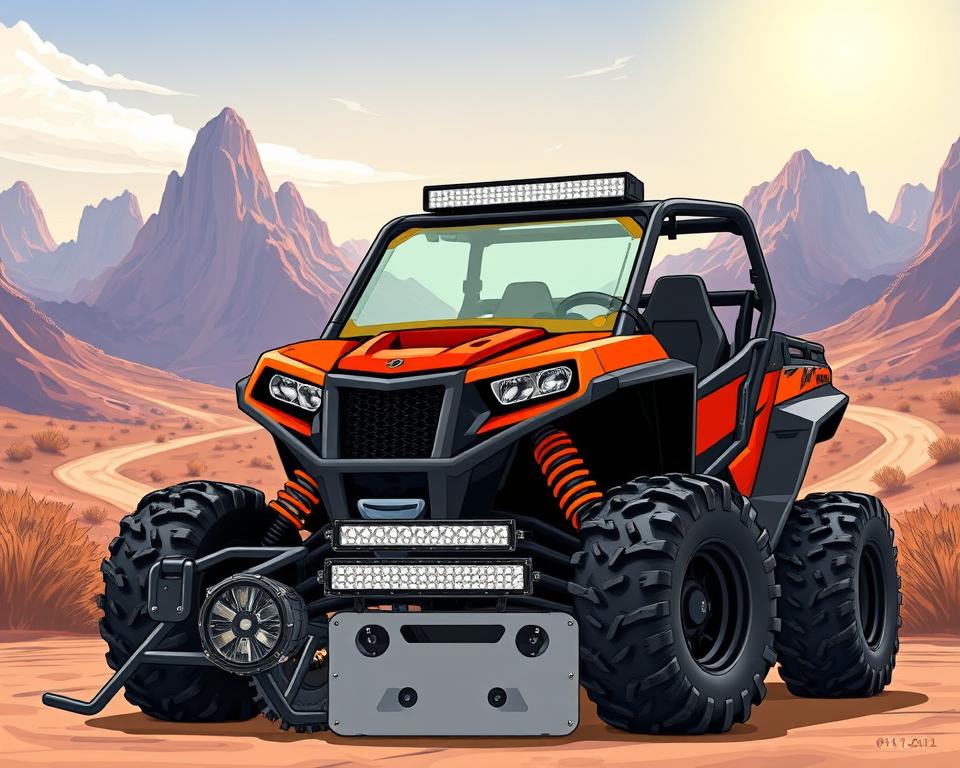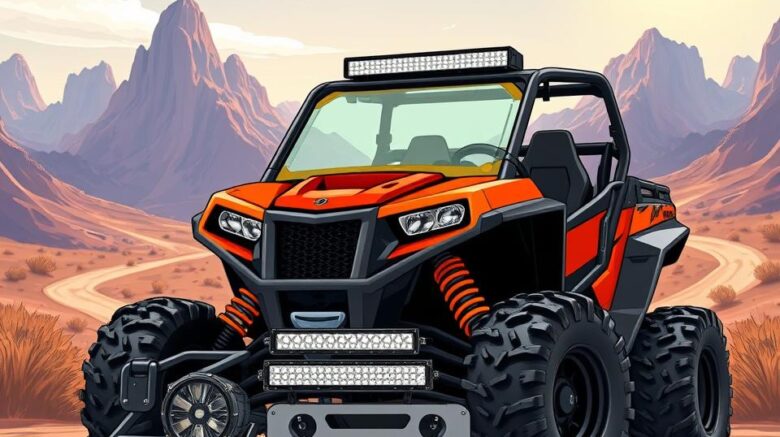Complete ATV Off-Road Safety Prep Guide
Remarkably nearly 450,000 ATV-related injuries are treated in U.S. emergency rooms each year? That startling statistic underscores why off-road safety and preparation are essential. The Essential ATV Off-Road Checklist is your guide to a safe and enjoyable ride. It covers everything from rocky trails to sand dunes. Armed with proper safety equipment and plow for Polaris sportsman 450 must-haves, you’ll reduce hazards and amplify the fun.
Core Lessons
- Prioritize safety by using the Essential ATV Off-Road Checklist for optimal preparation.
- Your gear list is critical for staying protected off-road.
- Keep your ATV running smoothly with routine care.
- Stay fueled and hydrated for peak performance.
- Don’t wander: rely on trusty navigation tools.
- Be ready for unexpected weather changes to stay comfortable during your adventure.
- Always carry essential tools and recovery kits for on-trail repairs and emergencies.
Understanding the Importance of Safety Gear
When you ride off-road, safety must come first. The excitement of ATVs brings potential hazards. Proper gear guards you against mishaps. Gear up correctly with this ATV safety gear checklist.

Essential Protective Gear
Maximizing protection involves several key items:
- Helmets: Choose DOT-approved helmets to prevent head injuries.
- Goggles: Protect your vision with wraparound goggles.
- Gloves: Wear durable gloves for better grip and hand protection.
- Footwear: Wear sturdy boots that cover the ankles to prevent injuries.
- Protective Armor: Aggressive riders should consider body armor for extra security.
- Neck Braces: A neck brace protects your spine in a crash.
Emergency Preparedness
Emergency preparedness is just as important as protective gear. An effective emergency kit can be a lifesaver in unexpected situations. Key items to include are:
- First aid kit
- Multi-tool
- Tire repair kits
- Portable air compressors
- Emergency blankets
- Whistles
- Matches
ATV Equipment for Optimal Performance
Gear choices affect how well your ATV runs. Knowing the must-have ATV equipment ensures you’re ready for any journey. Regularly following an ATV maintenance checklist helps maintain your machine’s functionality and longevity.
Must-Have ATV Equipment
- All-Terrain Tires: Invest in tires designed for various terrains to improve traction and handling.
- Cargo Systems: Mount racks or bags to carry your gear safely.
- Quality Fuel Tank: A high-quality fuel tank prevents leaks and ensures you have enough fuel for extended rides.
- Medical Kit: Be ready for scrapes and bruises with a first aid pack.
Regular Maintenance for Longevity
A maintenance schedule is your ATV’s best friend. Regular inspections should encompass:
- Inspect and clean or replace air filters regularly.
- Lubricating the chain to ensure optimal performance.
- Test your brakes on every pre-ride check.
Follow these steps to prep your ride for every trail.
The Essential ATV Off-Road Checklist
Good prep keeps surprise breakdowns away. Use this pre-ride checklist to avert trouble before it starts. Each pre-ride inspection step requires attention to detail. A thorough pre-ride assessment is key to a safe outing.
Pre-Ride Inspection Basics
Never ride without a quick systems check. This quick evaluation helps riders identify and address issues before they start. Key elements to check include:
- Tire pressure and tread condition
- Fluid levels such as oil and fuel
- Brakes and controls functionality
- Operational lights and horn
- Chain or driveshaft integrity
T-CLOC Inspection Method
T-CLOC covers every critical system. It covers Tires and Wheels, Controls, Lights, Oil and Fuel, and Chain/Driveshaft. This method ensures all critical areas are covered:
| Inspection Area | Checklist Items |
|---|---|
| Tires and Wheels | Check tire pressure, inspect tread depth, look for damage |
| Controls | Test brakes, throttle, and clutch for smooth operation |
| Lights | Ensure headlights, brake lights, and indicators are functioning |
| Oil and Fuel | Check oil level, inspect for leaks, and fill fuel tank |
| Chain/Driveshaft | Examine for wear, proper tension, and lubrication |
Spending a few minutes on this ATV maintenance checklist can make rides safer and more enjoyable. Prevent roadside repairs with a fast check.
Hydration and Nutrition for Long Rides
Stay fueled and hydrated for peak performance. Dehydration slows reaction and focus—pack extra water. Carry extra water to prevent fatigue and keep energy levels up during the adventure. The right snacks are also key for maintaining stamina on the trail.
Importance of Staying Hydrated
Drink often—don’t wait for thirst. A hydration pack with sip tube makes it easy. Consider using a hydration pack for convenience and to monitor water intake effectively.
High-Energy Snacks to Pack
The right fuel makes the ride smoother. Opt for non-perishable items that are easy to consume. Some ideal choices include:
- Protein bars
- Nut mixes
- Dried fruits
- Beef jerky
Snack smart for sustained energy. Ensure to pack a variety to keep your energy levels high and your taste buds satisfied.
Navigation Tools for Off-Roading Adventures
Stay on course with proven navigation aids. A dependable nav setup means you’ll always find your way.
Advanced GPS Systems
High-end GPS units guide you through the wild. GPS should work without cell service and last all day. Brands like Garmin and TomTom offer models designed for off-road use, ensuring durability and precision.
Traditional Navigation Aids
Technology is key, but traditional tools are also essential. Maps won’t die when batteries do. Map-and-compass know-how keeps you in control. Combining advanced tech with traditional aids prepares you for any situation on your journey.
Communication Equipment for Safety
Stay in touch even off the grid. Communication gear is as critical as your helmet. Knowing you can call for help reduces stress.
Group rides need reliable radios. These devices ensure clear audio over long distances. They allow for real-time updates on any changes or hazards. When choosing two-way radios, look for models with:
- Weatherproof construction to resist the elements
- Long battery life for extended trips without needing a recharge
- Multiple channels for clear communication without interference
Always include comms in your gear list. Group comms save time and reduce risk. Radios cut through noise and barriers. Stay connected, stay safe.
Self-Rescue Gear for ATV Riders
Every ATV rider should be ready for unexpected situations on the trail. With the right kit, you’ll tackle obstacles solo. Prepared riders make safer group members.
Winches and Recovery Kits
Winches are vital for self-rescue, helping pull your ATV from tough spots. A winch paired with a detailed ATV recovery kit is even more effective. Recovery kits usually include:
- Tow straps
- D-rings
- Recovery boards
- Gloves
Practice recovery techniques before you need them. With quality ATV recovery kits, you can overcome mud, rocks, or other obstacles and continue your journey.
Trail Recovery Essentials
Your toolbox should extend beyond the winch. These include:
| Equipment | Purpose |
|---|---|
| Recovery Straps | Used for towing or pulling ATVs out of tight situations. |
| Shovel | Helps clear obstacles and dig out vehicles when stuck. |
| Traction Mats | Provides grip under tires in muddy or slick conditions. |
| Portable Air Compressor | Enables quick tire inflation after deflating for better traction. |
Don’t rely on luck—bring the right tools. Knowing how to use these tools greatly improves safety and adventure on your off-road excursions.
Staying Adaptable: Preparing for Weather Changes
Trail weather can change in minutes. Your comfort and safety depend on proper weather prep. Pack for every possible forecast.
Dress in layers to stay comfortable. A dry base keeps you cozy. Mid-layers trap heat and pack small. Lastly, have a waterproof and wind-resistant outer shell. Adapt to cold, heat, or storms easily.
Weather-Appropriate Clothing
- Waterproof Jackets: Stay dry when the sky opens up.
- Ventilated Off-Road Pants: Pants that vent yet keep out the rain.
- UV Gear: Shield skin from sunburn with proper apparel.
- Cold-Weather Gloves: Keeps hands warm and functional during colder rides.
Quality weather gear is a must for a great off-roading experience. Stay focused on the trail, not on being wet or cold.
Tools for On-Trail Repairs
Your toolkit can make or break your day on the trail. Don’t skimp on repair gear. Fix flats and loose bolts in minutes.
Must-Have Tools and Kits
Keep these tools handy at all times. Pack only the essentials—no junk. Critical ATV repair tools might include:
- Tire irons for changing flat tires
- Pliers for gripping and cutting
- Wrenches for various sizes of bolts and nuts
- A multi-tool for versatility
- Spare items such as spark plugs and electrical wire
- Duct tape for quick fixes
Having these tools readily available boosts confidence and autonomy while exploring off-road trails.
Basic Emergency Supplies
In addition to essential tools, packing basic emergency supplies for ATV is vital. These supplies help ensure your safety in challenging situations:
- First aid kit for injuries
- Flashlight with extra batteries for night-time visibility
- Emergency whistle for signaling assistance
- Reflective triangles or flares to warn other riders
- Water and high-energy snacks for sustenance
Preparedness significantly impacts your off-roading experience. Never leave home without them.
In Summary
Well-planned rides are the best rides. Check off each item and pick reputable brands. This ensures you’re ready for any terrain.
With the right protective gear, navigation tools, and communication equipment, you’re set for safe riding. Prep wisely for peak thrills and protection. Embrace excitement, ditch the doubts.
Stay ready, ride with care, and enjoy the unforgettable moments off-roading offers. Every leg of the trip matters. Check this list, then conquer nature.
FAQ
What should I include in my ATV safety gear checklist?
Include a certified helmet and eye protection. Add gloves, boots, and torso protection. Consider a neck brace for extra safety. Remember to pack an emergency kit with a first aid kit and multi-tools for preparedness.
How do I keep my ATV in top shape?
Keep filters clean and chain well-lubed. Always test your brakes before a ride. Routine care prolongs longevity and readiness.
What is included in T-CLOC?
T-CLOC is a five-step pre-ride routine. Tires, Controls, Lights, Oil, and Chain are checked in T-CLOC. T-CLOC confirms all systems go for trail use.
Recommended hydration levels for trail rides?
Pack extra hydration for safety. Stay topped off to avoid dehydration. Hydro packs let you drink without stopping.
How to stay on course off-road?
Get a durable GPS with offline maps. Combine this with traditional aids like waterproof maps and compasses.
Why is communication important when off-roading?
Comms keep groups connected and safe. Radios work where phones don’t.
What self-rescue gear should every ATV rider carry?
Pack a winch plus full recovery gear. Include straps, shackles, and traction boards.
Tips for weather readiness off-road?
Use a base, mid, and shell layering system. Pack a rain shell to stay dry. Don’t forget sunscreen and UV-blocking apparel.
What tools should I pack for on-trail repairs?
Carry essential wrenches, pliers, and irons. Have spares and tape for quick fixes.
